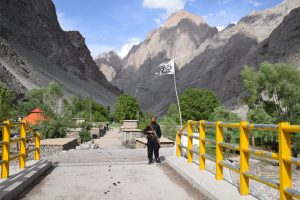NUSAI & MAIMAI, BADAKHSHAN, AFGHANISTAN — The two Taliban walked along the deserted dusty road, dwarfed by the massive rock cliffs towering all around them. The steady rushing of the water of the river snaking its way through the mountains swallowed the crunching sound of their steps.
As they wore no uniforms, it would have been possible to mistake them for two men on a stroll enjoying the scenery. But they were on a patrol to guard the border between Afghanistan and Tajikistan marked by the Panj River – one of many patrols that they and other Taliban conduct day and night.
At one point, the higher-ranking of the two stopped and gestured across the river: “There is a Tajik patrol over there.” On the distant road on the other side, there were three Tajik soldiers. Dressed in crisp light-green camouflage and determinedly marching at a set distance from each other, they contrasted starkly with their Taliban counterparts, who still looked mostly like ragtag rebels.
“They are always following us,” the Talib remarked.
Except that they were not. The Tajik soldiers only marched from one to another of their neat outposts along the border – facilities that the two Taliban, whose sub-unit even lacked a proper main base, could only dream of.
This and other impressions from an exclusive embed with Taliban border guards at a forlorn part of the Afghan-Tajik border in May of this year show that the Taliban are serious about guarding international borders, but also that their forces are ill-equipped. What’s more, they have a completely different threat perception than their neighbors and the international community.
Taking Over
After the Islamist Taliban marched into Afghanistan’s capital Kabul on August 15, 2021, culminating a lighting offensive with the overthrow of the internationally backed Afghan Republic, many worried what would come next. Would the Taliban and newly announced resistance groups start another chapter of the bloody war that has been haunting Afghanistan for more than four decades? Would the Taliban fail to govern and leave behind a chaos ready to be exploited by international jihadists and narcotics smugglers?
Almost two years later, the Taliban still rule practically all of Afghanistan, and frequently pride themselves of having brought peace and stability to the country. The fact that it was the Taliban themselves who, in the months and years before the fall of the Afghan Republic, initiated most of the violence – as well as the fact that most Afghans I know, including some Taliban, complain in private about Taliban rule, especially the dire state of the economy and various forms of repression and mismanagement – is dismissed as false propaganda by the Taliban regime.
While much of the criticism against Taliban rule is justified, the Taliban are right when they point out that concerns about another all-out civil war, state collapse, and utter chaos did not materialize. While the self-declared Islamic State and some resistance groups continue to conduct attacks, they are relatively few. Instances of major open violence are even rarer.
The state also did not collapse. Almost all state institutions survived the fall of the Republic, with the Taliban simply taking them over, frequently continuing to employ old Republican staff – a decidedly unexpected development, given the Taliban’s radically revolutionary outlook and constant vilification of all things related to the erstwhile Afghan Republic.
In the case of the army, including the border guards, it was only a bit different. Given that the armed forces of the Republic completely disintegrated during the Taliban takeover, the Taliban had to re-build them. However, they did so mirroring the organizational structure of the defeated army of the Republic. Re-established units have the same numbers, headquarters, and area of responsibility, with only few name and other changes, and for running the administration and other technical aspects the Taliban have regularly enrolled former soldiers and officers of the Republic.
This was also the case for the unit guarding the forlorn stretch of the Afghan-Tajik border in the districts of Nusai, Maimai, and Shekai in the northeastern Afghan province of Badakhshan that I visited. The Taliban there take their newfound positions seriously. Officers in the battalion HQ in Nusai dutifully plan which unit and soldiers will patrol when and where or perform other tasks, doing this on pre-printed schedules and forms in ledgers that are either the same as the Afghan Republic used or very similar. Soldiers who have completed a task have to confirm so by stamping their fingerprints on the same forms, a common replacement for a signature given the high rate of illiteracy in Afghanistan.
“The whole day is clearly structured,” one Taliban officer further elaborated. “Every morning after prayers, all soldiers with no special duties have to attend theory lessons and general exercise followed by various assigned tasks such as guard duty and patrols.”
In the smaller units in the field, the atmosphere is less military and more improvised. But also in such outposts, there is no slack. For example, the men from the block in Tangshew, a side valley in Maimai and one of the most remote postings, are patrolling day and night, hardly ever sleeping more than a very few hours.
“It is good that everywhere we go, there are mountain streams. If we get tired, one splash of their always ice-cold water in the face gets us awake again,” one Talib soldier said when asked whether they did not get exhausted.
All in all, and contrary to common perception in the West, the Taliban indeed try to run a responsible government, including guarding Afghanistan’s international borders. The problem is that the Taliban are not as adept at governing as they claim – and that they have a completely different outlook on border security than neighboring states.
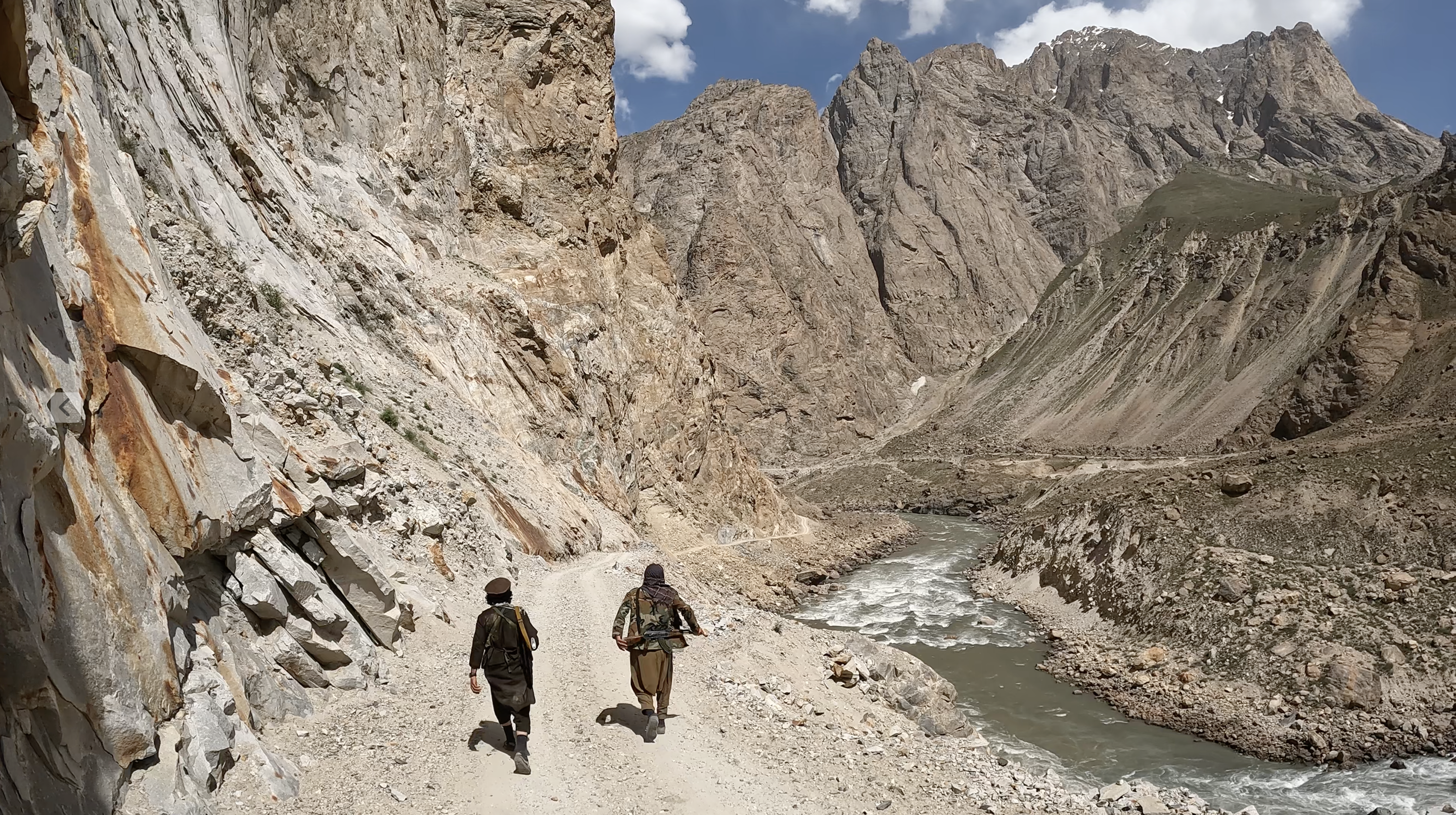
Two Taliban border guards patrolling a remote stretch of the long Afghan-Tajik border marked by the Panj River, Maimai District, Badakhshan, Afghanistan, May 14, 2023. Photo by Franz J. Marty.
Shortages
While official slick propaganda videos frequently posted by the Taliban show their armed forces as impeccably uniformed, well-equipped, and professional soldiers, the reality looks a bit different.
Most immediately apparent is the lack of uniforms of many soldiers. Most of the Taliban border guards in Nusai, Maimai, and Shekai, as well as along the 21-hour-drive to get from Badakhshan’s capital Faizabad to Nusai, lacked uniforms and still wore traditional Afghan tunics as during their days as an insurgency. And this only foreshadowed much more serious issues.
For example, the battalion that is responsible for guarding the Afghan-Tajik border in Nusai, Maimai, and Shekai had in total only three functioning vehicles. “Only one, a Toyota Hilux, was officially provided by the chain of command; the other two, both Ford Rangers, are from the private war loot of Juma Khan [the main local Taliban commander],” one Talib explained.
One outpost in Shekai used to have another Ford Ranger, but it has long sat on the side of the road, hamstrung by flat tires and other irreparable damage.
“Please tell Taliban officials in the center of Badakhshan and in Kabul that we really do need a car,” a Talib commander there asked me. His prior pleas via usual official channels had yielded no results.
A higher-ranking officer in the brigade HQ said he faced the same problems when he tried to secure additional vehicles for the Nusai battalion and other units.
Others were even in a more dire situation. While on most outposts one or several Taliban at least have private motorcycles to travel along regularly long distances in the only sparsely inhabited sprawling mountain landscape, the outpost in Tangshew does not even have that.
Also here a Talib asked me to help: “We need at least a motorcycle, as we cannot cover our whole area of responsibility on foot.”
This lack of proper vehicles is also not limited to forlorn border areas. When asking in the Taliban army division in Faizabad whether I might hitch a ride on a military vehicle to Nusai, an officer replied that they do not have many vehicles and do not drive frequently there. “The majority of our soldiers go there by shared cabs [on this route, Toyota Land Cruisers], which are anyway better than our cars,” the officer added, seemingly not realizing what light this cast on the state of his division.
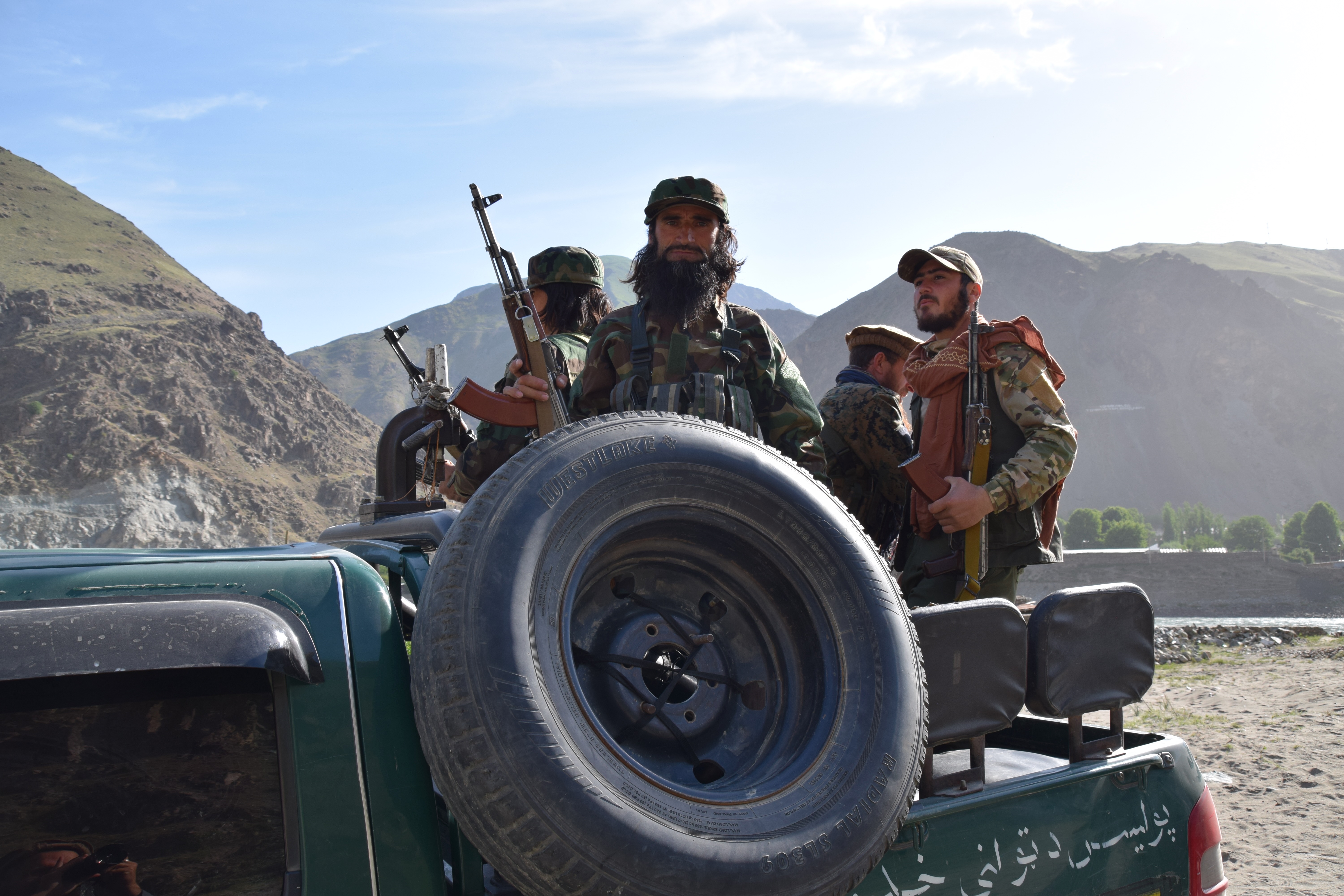
Taliban border guards riding on one of only three vehicles that the battalion in Nusai, Badakhshan, Afghanistan, possesses, May 11, 2023. Photo by Franz J. Marty.
With respect to armament, in some smaller units at the border the situation is even more peculiar. “Our company has 41 men and we have a total of only nine assault rifles,” a Taliban officer in Chormaj Bolo in Maimai said. In the block in Tangshew, it was only 10 rifles for 25 men.
They also face ammunition shortages. “I have only bullets in three magazines, each of which takes 30 bullets but none of which is full,” one soldier said.
“For our only PK [belt-fed machine gun] we have only about 100 bullets left,” his comrade added. He then picked up the gun, mockingly aiming at a bridge spanning a tributary to the border river and the still snow-capped craggy mountains in the distance. “We would be swiftly shot out.”
Taliban soldiers at the border in Badakhshan not only lack sufficient uniforms, vehicles, weapons, and ammunition, but also payment. Numerous Taliban border guards in Nusai and Maimai all told me that none of them had been paid their salary since September 2022 – a gap of more than six months at that time. And while some money continued to arrive to cover food and other expenses in the bases and outposts, Taliban officers in Chormaj Bolo and Tangshew said that they pay rent from their own pockets for the bare and simple mud-walled rooms that they lease from locals to use as rudimentary HQs.
In Tangshew, this room is a 1.5-hour foot march away from the border, more than suboptimal for a border protection force.
“We started building a small house for our unit right at the border, but then we did not receive any payments anymore and we could not complete the work,” one of the border guards said. Low unfinished walls of neatly stacked natural stones on one of the few even spots between the rock cliffs, the only road, and the border river bore witness to his comment.
How Taliban border guards apparently nonetheless manage to pay rent and feed their families without salary is puzzling. Asked about it, almost all Taliban reply “Allah provides” or some variation of it.
One Talib, when pushed, was more honest: “We get what we need on credit. But I cannot run up debts like this. I am in favor of the Taliban, but if I am not paid soon, I will be forced to quit and till my land or emigrate to provide for my family,” he eventually said. Others saw it the same way.
For anyone who has spent time in Afghanistan, such complaints about supply and equipment shortages, soldiers not getting paid, and general neglect ring a not distant bell. Similar stories were widespread among soldiers and policemen of the toppled Afghan Republic, right up until the latter’s overthrow in August 2021.
“We are aware of these problems, and they are being resolved, including payment of all past salaries,” Fasihuddin Fetrat, the Taliban’s Army Chief of Staff, replied to me later in May 2023 after I relayed the complaints of his soldiers.
“The reason for all these issues is that we upgraded the border force unit in Nusai from a company to a battalion and the battalion has not yet been formally taken on the books,” he added.
Why this could not be resolved during several months remained unclear. The difficult circumstances of having just established a new army – and transporting equipment to all corners of a hardly developed mountainous country – might explain some delay, but not one of over six months. This is all the more the case, as the Taliban frequently boast about how they face no notable issues, how many vehicles of the old army they have repaired, and how they have safeguarded the vast armories of the Afghan Republic.
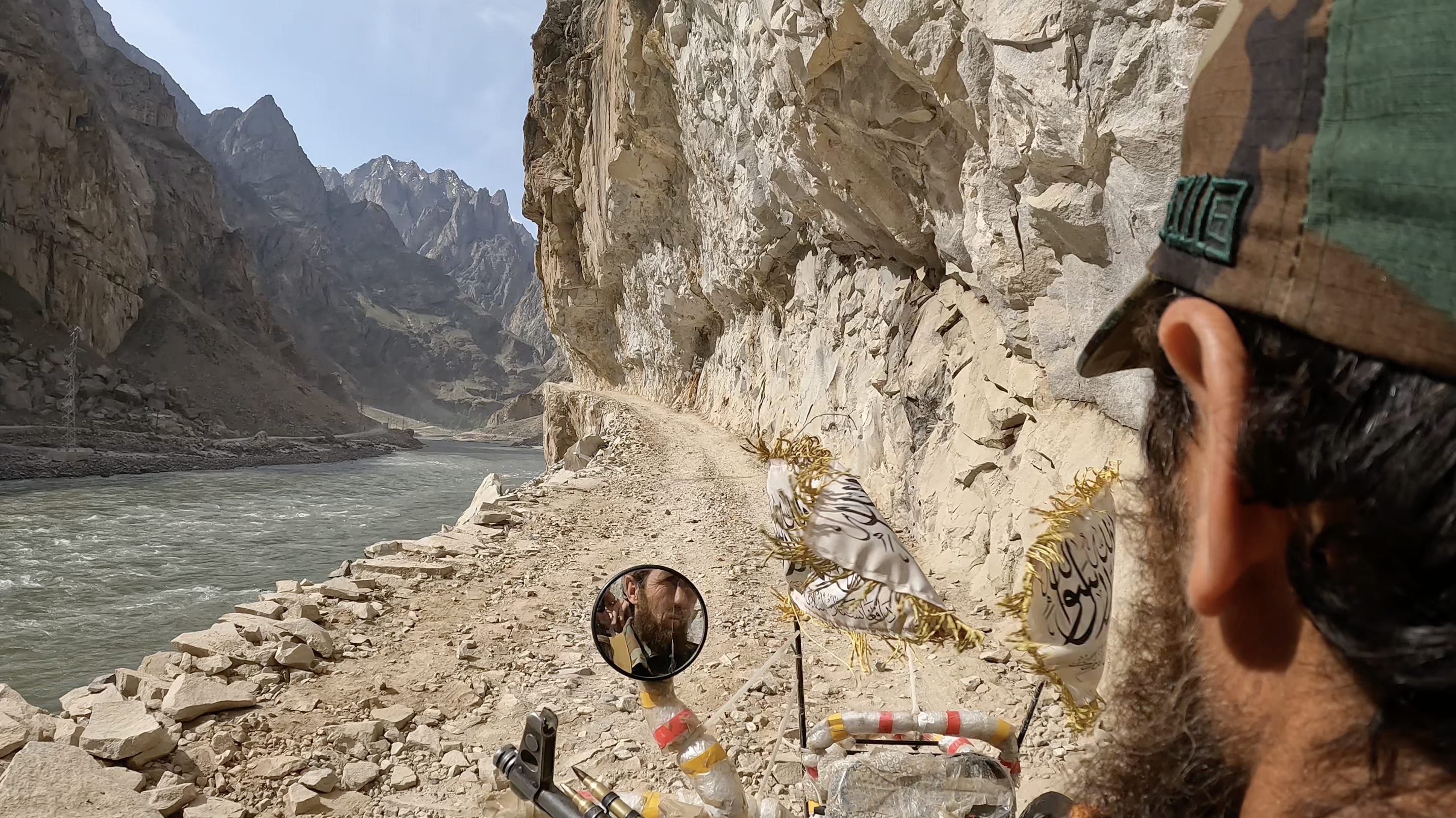
Hitching a ride with a Taliban soldier driving on a motorcycle along the Panj River that makes up the Afghan-Tajik border, Maimai District, Badakhshan, Afghanistan, May 13, 2023. Almost none of the Taliban units on this stretch of the border have vehicles. The few border guards who have private motorcycles regularly use them on duty to cover the often long distances. Photo by Franz J. Marty
Looking for Resistance
Even if the above problems were eventually resolved, all would not be well. While the Taliban in the units I visited were all dedicated to guard the border, most of them did not really seem to know what exactly they are doing.
Asked about why they patrol, most Talib border guards replied that they are looking for mukholefin — meaning “opponents.” When I followed up, some clarified that they were talking about the Resistance, shorthand for the National Resistance Front. The anti-Taliban group is led by Ahmad Massoud, the son of late Ahmad Shah Massoud who famously put up armed resistance against the Soviet Union in the 1980s and later the Taliban during their first reign of Afghanistan that ended with the U.S.-led intervention in Afghanistan in the wake of the 9/11 attacks.
“Tajikistan shelters the Resistance. There are 300 soldiers from the old Afghan army in Tajikistan, trying to strike us from across the river,” one young blonde Talib border guard in Nusai gravely said, echoing statements of others.
According to one Talib officer in Nusai, looking for the alleged Resistance presence on the Tajik side was also directly ordered. “In early 2023, a written order arrived from the brigade. It stated that the Resistance is a threat and that they were given places in outposts on the Tajik side right at the border river,” he elaborated.
Some Taliban border guards even claim that the Resistance is a serious problem on the Afghan side of the border. “The main threat for us comes from up [Tangshew] valley, not from down [the border],” one Talib said. It was a peculiar statement for a border guard.
The presence of some Resistance members up-valley, in a remote, large area known as Shewa, is possible. In September 2022, the Taliban launched a bigger operation against the Resistance in Shewa, which dealt a blow to the latter. Another Talib officer acknowledged though that, as of May 2023, 50 to 60 Resistance fighters still remained there. The assertion of the Talib soldier that these Resistance fighters would take over whole border areas if the block of Taliban border guards in Tangshew was not there and patrolling the upper valley is a clear exaggeration, though.
This focus on Afghan resistance to Taliban rule in Badakhshan is not limited to Maimai and Nusai. In mid-May, Taliban notables in the provincial capital, Faizabad, referred to past explosions in their city and possible problems in Khwahan District, and were very concerned about the wounding of a Taliban soldier in Keron wa Manjon District. The Taliban soldier was shot three times by unknown perpetrators. “And that in his own house,” one of the highest-ranking Taliban in Badakhshan said in disbelief.
Such open acknowledgement of concern about resistance from Afghans in Badakhshan is surprising as it not only contradicts the Taliban’s own propaganda, according to which there is no resistance to their rule, but also because it is objectively hardly justified.
The National Resistance Front’s attempts to hold out in Panjshir, a province located between Kabul and Badakhshan, were short-lived. On September 6, 2021, about three weeks after the fall of the capital Kabul and the rest of the country, Taliban forces took over Panjshir with resistance fighters scattering into remote mountain areas. And while the National Resistance Front continues to target the Taliban in small attacks in Panjshir and elsewhere, such incidents are limited and currently no significant threat to Taliban rule.
The same is true for other resistance groups, most notably the Afghanistan Freedom Front. Some of them indeed found shelter in Tajikistan. However, there is no credible indication that Tajikistan is providing additional support, not to speak of letting them use Tajik outposts right at the border.
In view of all this, border guards have trouble articulating what, exactly, they are looking for when patrolling. “We look out for anything suspicious,” a Talib in Maimai asserted. Despite several efforts, he and others failed to say what this actually means. Most if not all border guards in Nusai and Maimai appear to patrol for the sake of patrolling, hardly looking out for anything.
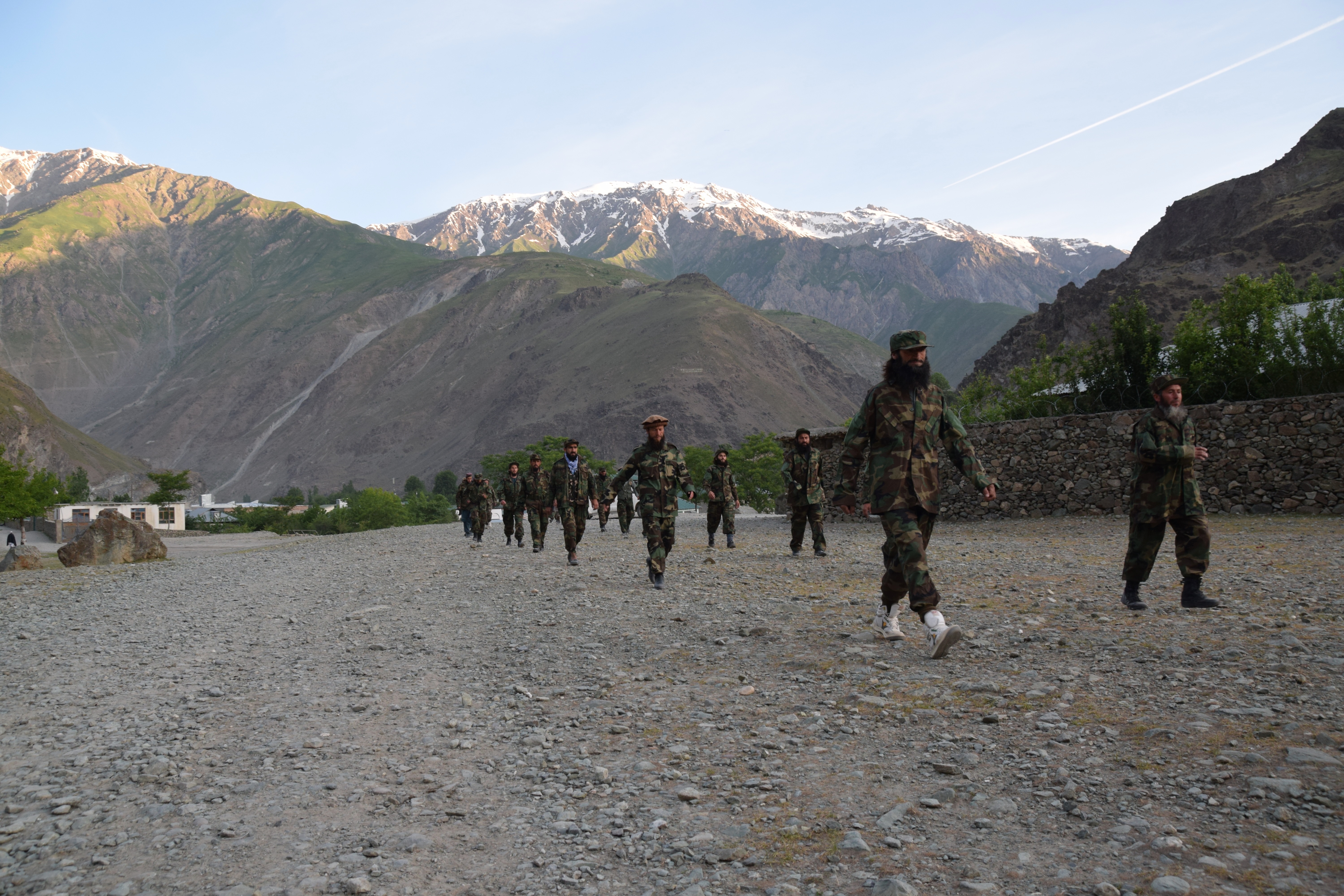
Taliban border guards of the Nusai battalion during their daily morning exercise, Nusai, Badakhshan, Afghanistan, May 11, 2023. Photo by Franz J. Marty.
The only time a patrol did find something during my visit was rather peculiar. Driving along the border road in Nusai, the Taliban riding on the cargo load in the back of the Ford Ranger suddenly got agitated, beckoning the driver to stop. As soon as the car came to a halt, they jumped down, with two or three of them shooting five to six bullets into the mountain side. Eventually, it turned out that they had spotted – and shot – a snake. With Kalashnikov rifles.
“All snakes here are poisonous, and it would have been a danger for passing people or cattle,” one Talib claimed. Even if the snake was poisonous, the response was an overkill, an assessment with which one Talib agreed. Locals and border guards on the Tajik side must have even wondered more what the shots were about.
A Talib officer later recounted yet another questionable patrol episode that also took place in Nusai in mid-May. “In the darkness of one night, a patrol of the [Taliban’s] intelligence service mistook our men [i.e a border guard patrol] for Resistance enemies,” he said. “They had already laid an ambush and were in firing positions when they finally realized their mistake,” he added, laughing. The fact that they barely avoided a bloody friendly fire incident did not seem to bother him much.
Checking the very few cars that pass along the road following the border is also affected by soldiers apparently mindlessly following questionable orders. At every one of the few checkpoints on the long drive along the border, as in any other place elsewhere in the country, Taliban soldiers dutifully stop cars, but then only ask “Where have you come from?” and “Where are you going to?” That the generic replies of drivers hardly tell anything of relevance and could anyway be easily made up does not seem to occur to the Taliban. Soldiers apparently simply have to ask these questions so that they are asking something.
In at least one case, Taliban even missed one of the very few passing cars in Maimai, as the Taliban who were supposed to conduct controls, to escape the hot sun, rested in the only shadowy spot available – which did not allow a clear view of the road.
While similar things arguably occur to some extent in any military, within the border guards in Nusai and Maimai, they seem more serious and the norm. And the outlined problems are apparently neither recognized nor addressed.
In mandatory morning lessons in the battalion HQ in Nusai, which could be used to improve such issues, the focus certainly lies elsewhere. The lessons consist of listening to excerpts of the Holy Quran in original Arabic and translation and religious lessons whose topics range from practical, but hardly pressing (e.g. how to cover bodies for burial), to odd (e.g. prayers during a solar eclipse) and concerning (e.g. that Islam has no borders and that national borders should be torn down in jihad).
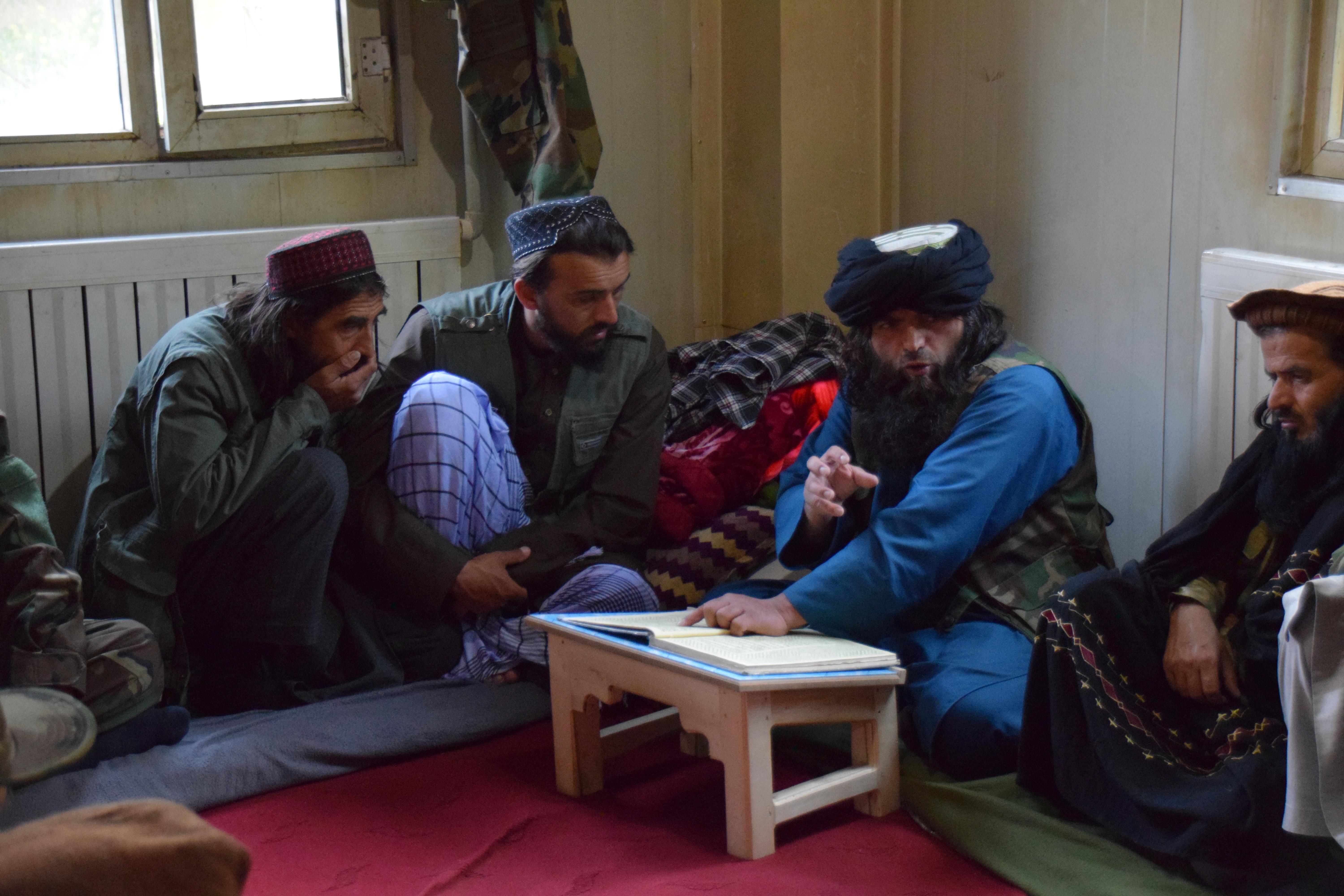
A mullah giving Taliban border guards religious lessons as part of a daily routine, Nusai, Badakhshan, Afghanistan, May 11, 2023. Photo by Franz J. Marty
Denial of Other Threats
In a stark contrast to their worries about the Resistance, Taliban border guards downplay or deny concerns of neighboring countries and the wider international community about narcotics smuggling and foreign jihadists residing in Afghanistan.
“Our emir banned the production and trade of narcotics, so this problem has been resolved,” one Talib in Nusai asserted.
While the Taliban indeed enforced this order from April 2022 and significantly reduced narcotics production, the Taliban in Nusai act as if the order alone magically and completely resolved this vast issue. Trying to have a more differentiated discussion about remaining narcotics production and trafficking – for example, pointing to detailed research showing that contrary to other places, in Badakhshan opium production has so far not been reduced – is a futile effort. Taliban simply reject any contestation of their assertions, which is obviously more than problematic for any serious engagement with their regime.
Similar problems also affect worries about foreign jihadists inside Afghanistan. “There are no foreign fighters here,” one Talib said, repeating the constant refrain of the Taliban Emirate.
Asked about a graffiti tag reading “M ARSALON,” the nom de guerre of a jihadist hailing from Tajikistan, painted on a rock in Nusai that is facing toward Tajikistan, two Taliban officers eventually acknowledged that Arsalon and some other fighters from Tajikistan used to be in Nusai. “He was a dangerous man,” one of the officers said. “He and other Tajikistanis left after our victory [over the Afghan Republic],” he then claimed, adding, “I don’t know where to.”
According to a recent U.N. report, Mehdi Arsalon, whose real name was Muhammad Sharipov, was killed in Kabul in September 2022. Recently, though, one well-placed source mentioned that Arsalon might still be alive.
That said, well-placed other sources corroborated that there are indeed no Tajikistani jihadists anymore at the border in Afghan Badakhshan. However, these sources also credibly stated that such jihadists had only moved – first to other places in Badakhshan and, in June 2023, to other Afghan provinces, first and foremost the northern Afghan province of Kunduz, which also borders Tajikistan. The same sources also said that the militants remain largely unrestricted and in close contact with the Taliban.
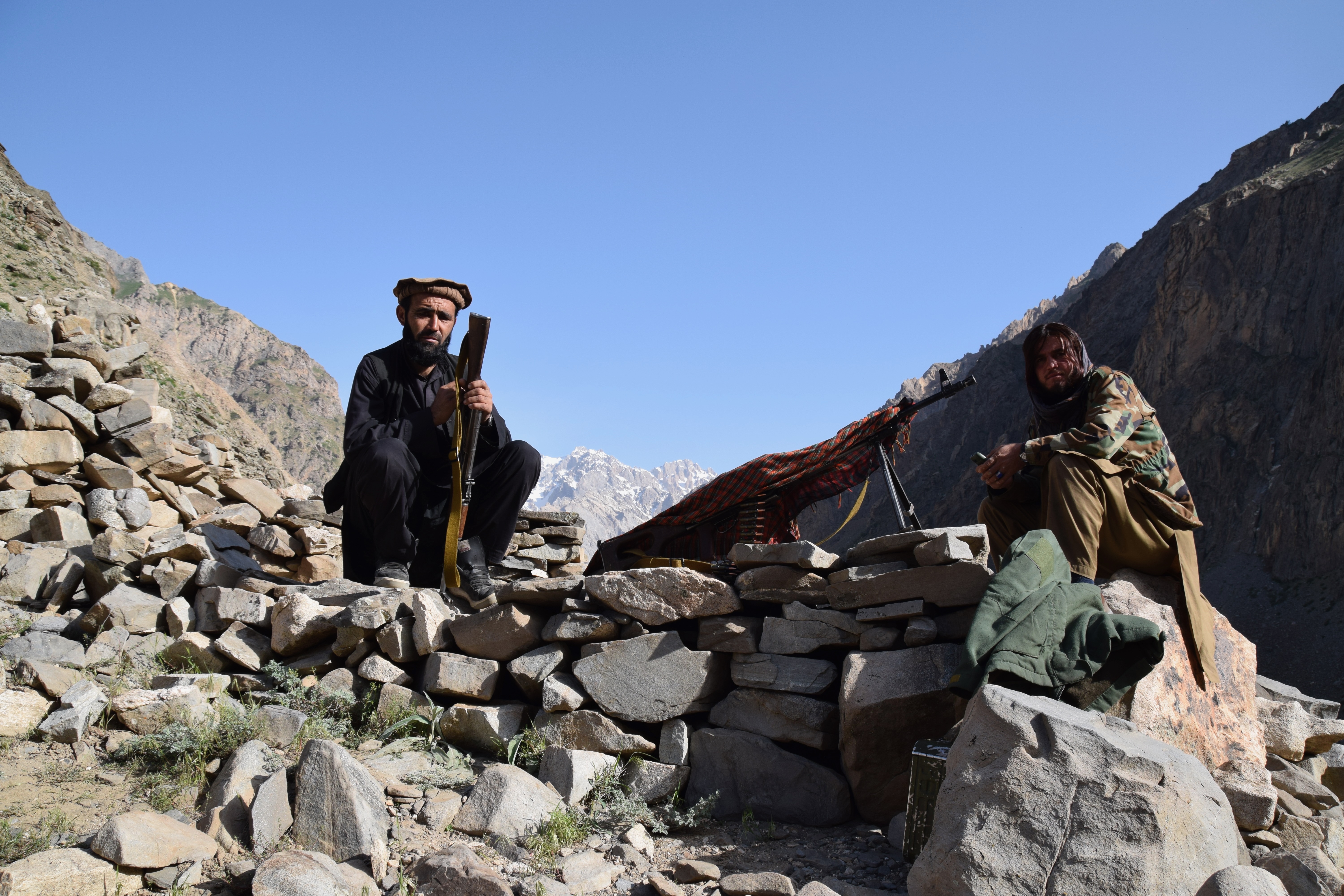
Taliban border guards in a rudimentarily fortified position in the Tangshew valley, one of the most remote postings in an already remote region, Maimai District, Badakhshan, Afghanistan, May 14, 2023. Photo by Franz J. Marty.
The fact that Tajikistani jihadists are not located right at the border anymore, does also not mean that the threat has been neutralized. Tajik authorities as well as the independent Tajik news outlet Bomdod reported that, in late April 2023, a group of jihadists who hail from Tajikistan but have been residing in Afghanistan crossed the Tajik border river to conduct “terrorist operations” in Tajikistan. On the Tajik side, they were soon detected by Tajik security forces and a firefight ensued.
While official Tajik statements implied that only two men crossed and were “neutralized,” a well-placed source as well as a Tajik local cited by Bomdod asserted that three to four more men crossed – and managed to escape.
Confronted with this, several Taliban in Badakhshan rejected that any such incident took place. “It’s all lies,” exclaimed a Talib of the unit in whose area of responsibility the incident happened.
The exact place of the reported crossing was between the village of Amurn on the Afghan side and the mouth of the Yazgulem valley on the Tajik side. The border river, Panj, flows quietly there, making it easier to cross. And it is also a good spot if one wants to avoid Taliban patrols: The place lies right at the border between the areas of responsibility of two Taliban border guard units, and is so far away from the responsible block that Taliban patrols visit it at best every two weeks or so.
When I pointed this out and asked the Talib how they can be sure that nothing happened, if they only rarely go to the area, he evasively replied that they would have heard it from locals.
Another Talib, more honestly, agreed with me: “He is right; we can’t know.”
To be fair, even the most professional and best equipped border force in the world would not be able to control every spot along such a rugged and remote border. However, the fact that Taliban border guards in Badakhshan are indeed thinly spread and not only ignore but outright deny clearly existing concerns of illegal crossings (and there are other examples at the Afghan-Pakistani border), is a worrisome mix.
All this – the Taliban’s paranoia about hardly active armed resistance and their blatant denial of other cross-border threats that worry neighboring states and the wider international community – do not bode well for any interaction between the Taliban and other states. The parties involved are talking at cross-purposes.
A change in this is also unlikely. Most Taliban, like the ones who felt shadowed by Tajik patrols on the other side of the river, are convinced that everyone is actively plotting to overthrow their Emirate. Accordingly, the Taliban are set to continue patrolling their borders, looking for mostly imagined enemies.













